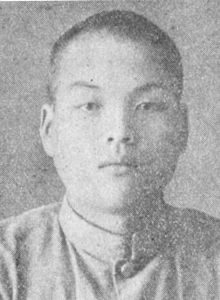|
Tsuyama massacre
The Tsuyama massacre (津山事件, Tsuyama jiken) was a revenge spree killing that occurred on the night of 21 May 1938 in the rural village of Kamo close to Tsuyama in Okayama, Empire of Japan. Mutsuo Toi (都井 睦雄, Toi Mutsuo), a 21-year-old man, killed 30 people,[1] including his grandmother, with a Browning shotgun, katana, and axe, and seriously injured three others before killing himself with the shotgun. It is the deadliest shooting by a lone gunman in Japanese history. MassacreMutsuo Toi cut the electricity line to the village of Kamo on the evening of 20 May, which left the community in darkness. At around 1:30 a.m. on 21 May, he killed his 76-year-old grandmother by decapitating her with an axe in her sleep.[2] Armed with a modified shotgun, a katana, an axe, several daggers and 200 rounds of ammunition,[3] he strapped two flashlights to his head and prowled through the village like a youth engaged in "night-crawling" or "Yobai" (夜這い), entering the homes of his neighbors. He killed 29 neighbors, 27 of whom died at the scene of the incident, while two others were fatally wounded, dying of their injuries later,[4] and seriously injured three others, in about an hour and a half. This was almost half of the residents of the small community.[2] At dawn, he committed suicide by shooting himself in the chest on a nearby mountain.[5][6] Perpetrator Mutsuo Toi (都井 睦雄, Toi Mutsuo, 5 March 1917 – 21 May 1938) was born in Okayama Prefecture to well-off parents. His parents died of tuberculosis when he was a baby, so he and his sister were brought up by their grandmother. He was originally outgoing, but at the age of 17 he became socially withdrawn after his sister married in 1934. He was interested in the story of Sada Abe, the prostitute who, in May 1936, strangled her lover then severed his genitals. He had started writing a novel, Yūtokaiōmaru (雄図海王丸).[citation needed] He took part in "Yobai" (夜這い) or "night-crawling", a rural custom which involved creeping into young women's bedrooms during the night to seek sexual intercourse.[4] His suicide notes indicate that after May 1937 he was diagnosed with tuberculosis, and the young women in the village rejected his sexual advances.[7] LocationThe massacre was carried out in the small village of Kamocho Kurami, now part of the city of Tsuyama. The village has since been merged with different towns and cities over the years due to depopulation. The village's population at the time of the massacre was 23 households and 111 people.[citation needed] After the massacre, some families moved away. Most of the residents in the village state that no one has moved to Kurami since the massacre. In 2015, the house that Mutsuo Toi lived in was demolished, after sitting abandoned for years. Suicide notesToi left several long notes which revealed that he was concerned about the social impact of his tuberculosis, which in the 1930s was an incurable fatal illness. He felt that his female neighbors became cold towards him once they knew of his illness, and that he was despised as hypersexual. He stated in the notes that neighbors insulted and treated him badly after he was found to have tuberculosis. For revenge, he decided to enter their homes and kill them. He waited for the time when the women returned to their houses. The authorities were concerned, and his gun license was revoked. He prepared swords and guns secretly. He regretted that he would not be able to shoot some people he wanted to, as that would have involved killing people he regarded as innocent. He wrote that he killed his grandmother because he could not bear leaving her alive to face the shame and social stigma that would be associated with being a "murderer's grandmother". FilmsThe 1983 Japanese film, Ushimitsu no mura [ja] (Village of Doom), was based on the massacre. It stars Masato Furuoya as Tsugio Inumaru, an emotionally distraught young man who goes on a violent killing spree after his tuberculosis keeps him from serving in World War II. Furuoya committed suicide by hanging on 25 March 2003, twenty years after the film's release.[8]
See also
ReferencesNotes
Bibliography
|
||||||||||||||||||||||||||
